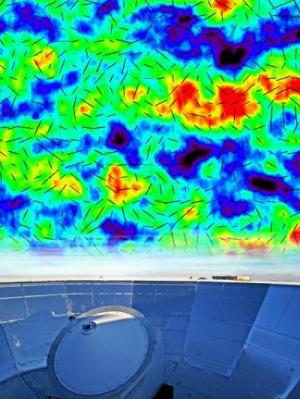 A detailed picture of the seeds of structures in the universe has been unveiled by an international team co-led by Sarah Church of the Kavli Institute for Particle Astrophysics and Cosmology, jointly located at the Department of Energy"s SLAC National Accelerator Laboratory and Stanford University, and by Walter Gear, of Cardiff University in the United Kingdom. These measurements of the cosmic microwave background -- a faintly glowing relic of the hot, dense, young universe -- put limits on proposed alternatives to the standard model of cosmology and provide further support for the standard cosmological model, confirming that dark matter and dark energy make up 95% of everything in existence, while ordinary matter makes up just 5%.
A detailed picture of the seeds of structures in the universe has been unveiled by an international team co-led by Sarah Church of the Kavli Institute for Particle Astrophysics and Cosmology, jointly located at the Department of Energy"s SLAC National Accelerator Laboratory and Stanford University, and by Walter Gear, of Cardiff University in the United Kingdom. These measurements of the cosmic microwave background -- a faintly glowing relic of the hot, dense, young universe -- put limits on proposed alternatives to the standard model of cosmology and provide further support for the standard cosmological model, confirming that dark matter and dark energy make up 95% of everything in existence, while ordinary matter makes up just 5%.
A detailed picture of the seeds of structures in the universe has been unveiled by an international team co-led by Sarah Church of the Kavli Institute for Particle Astrophysics and Cosmology, jointly located at the Department of Energy' + char(39)+ N'" SLAC National Accelerator Laboratory and Stanford University, and by Walter Gear, of Cardiff University in the United Kingdom. These measurements of the cosmic microwave background -- a faintly glowing relic of the hot, dense, young universe -- put limits on proposed alternatives to the standard model of cosmology and provide further support for the standard cosmological model, confirming that dark matter and dark energy make up 95% of everything in existence, while ordinary matter makes up just 5%.
"When I first started in this field, some people were adamant that they understood the contents of the universe quite well," said Church, deputy director of KIPAC and the U.S. principal investigator of the QUaD project. "But that understanding was shattered when evidence for dark energy was discovered. Now that we again feel we have a very good understanding of what makes up the universe, it' + char(39)+ N's extremely important for us to amass strong evidence using many different measurement techniques that this model is correct, so that this doesn' + char(39)+ N't happen again."
In a paper published in the November 1 issue of The Astrophysical Journal, QUaD researchers release detailed maps of the cosmic microwave background (CMB). The researchers focused their measurements on variations in the CMB' + char(39)+ N's temperature and polarization to learn about the distribution of matter in the early universe. Polarization is an intrinsic extra "directionality" to all light rays that is at right angles to the light ray' + char(39)+ N's direction of travel. Although most light is unpolarized -- consisting of light rays with an equal mix of all polarizations -- the reflection and scattering of a light ray can create polarized light. This property of light is exploited by polarized sunglasses, which block some of the polarized light to reduce glare on sunny days.
The light from the early universe was initially unpolarized but became polarized when it struck moving matter in the very early universe. By creating maps of this polarization, the QUaD team was able to investigate not just where the matter existed, but also how it was moving.
"These new polarization measurements from QUaD are the most sensitive ever made," said Clem Pryke, QUaD team member and assistant professor at the Kavli Institute for Cosmological Physics, located at the University of Chicago.
The QUaD results very closely match the temperature and polarization predicted by the existence of dark matter and dark energy in the standard cosmological model, offering further experimental confirmation that the model is correct. These findings also limit the possibilities of alternative models, reinforcing the view that researchers are on the right track and need to learn more about the strange nature of dark energy and dark matter if they are to fully understand the workings of the universe.
"Microwave background observations are about the most technically challenging in contemporary astrophysics and cosmology," said KIPAC Director Roger Blandford. "It is wonderful to see such solid measurements and such a clear confirmation of the theory."
The QUaD (QUEST at DASI) project utilizes the Q U Extra-galactic Survey Telescope (QUEST) instrument at the South Pole that was installed on the mechanical structure from a previous experiment called DASI (Degree Angular Scale Interferometer).
The principal members of the QUaD collaboration are the Kavli Institute for Particle Astrophysics and Cosmology at Stanford University and the Department of Energy' + char(39)+ N's SLAC National Accelerator Laboratory, the Kavli Institute for Cosmological Physics at the University of Chicago, the California Institute of Technology, the Jet Propulsion Laboratory, Cambridge University (United Kingdom), Cardiff University (United Kingdom), University of Edinburgh (United Kingdom) and Maynooth College (Ireland).
The National Science Foundation funded the U.S. portion of the experiment, the Particle Physics and Astronomy Research Council funded the U.K. research and Enterprise Ireland funded the Irish contribution.
SLAC National Accelerator Laboratory is a multi-program laboratory exploring frontier questions in astrophysics, photon science, particle physics and accelerator research. Located in Menlo Park, California, SLAC is operated by Stanford University for the U.S. Department of Energy Office of Science.

 Previous page
Previous page Back to top
Back to top







